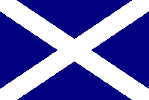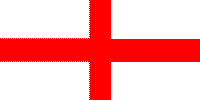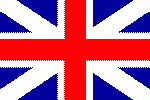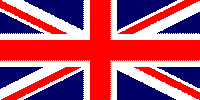T
HE CROSS OF ST PATRICK
A small correction concerning your recent contribution on the British Union. There is no such thing in the symbology of the Irish people as the Cross of St Patrick. Ireland was always represented by the harp. The cross of St Patrick was the family crest of an aristocratic planter family in northern Ireland, not native Irish. It was chosen for the Irish as their fictitious emblematic representation in the enforced and spurious union. It is not old; it is not authentic. This is one of the many reasons Australian Nationalists reject the "Jack" having a place in our own symbology or that of our ancestors.
A SEARCH on the Internet brought up the gem quoted above on a discussion list. Now, Australian nationalists may well have a good reason to remove the Union Flag from their own homeland’s flag. There’s no contest about that. However, the rest of the writer’s argument regarding the Cross of St Patrick is untrue. He claims, ‘It is not old; it is not authentic.’ This is a common argument, but it has no basis in fact. The Red Saltire was not just cobbled together in 1800 to fit in the Union Flag. It is in fact older than he realises – at least 300 years older than the Tricolour of Green, White and Orange and at least fifty years older than the Green Harp Flag.
Professor G A Hayes-McCoy devotes an entire chapter to the Cross of St
Patrick in his magnificent posthumously published work, A History of Irish
Flags from Earliest Times (Academy Press, Dublin 1979). He marshals
evidence to indicate that Red Saltire flags were known as early as the Battle of
Kinsale in 1601. A contemporary map of the battle - preserved in Trinity
College, Dublin – shows the positions of the English army and their opponents;
a combined force of Irish and Spanish troops. The English forces are shown to
carry a number of flags, quite obviously St George’s Crosses. Their opponents
– Henry McShane O’Neill’s infantry and his Spanish allies - are shown to
carry flags bearing Red Saltires.
Now, some folk argue that the Spanish Cross of Burgundy is a red ‘saltire raguly’ in which the arms of the cross have regular slots and notches in them as if they had been sawn off a tree trunk. It is likely, they argue, that the scale of the map is too small to show the irregularities in the arms of the cross. So there it is, the Red Saltire is has nothing to do with Ireland at all – it’s a Spanish flag! This sounds plausible, but doubts remain.
The writer is mistaken to say that the Cross of St Patrick ‘was the family crest of an aristocratic planter family in northern Ireland (sic), not native Irish.’ The family crest in question is that of the Fitzgeralds. Their lineage goes back to the Norman conquest of the 12th Century. They are not ‘northern planters’, although they most certainly were aristocrats.
More than a century before the Battle of Kinsale, Gerald Fitzgerald VIII – known as the Great Earl of Kildare – ruled Ireland as a Viceroy. He sought to gain greater self-government of Ireland for the Anglo Irish colony, led by his own family. The arms of the House of Kildare are described as ‘argent a saltire gules’ a red diagonal cross on a white field – the same as the Cross of St Patrick. He was accused in 1467 of flying his standard treasonably from Carlow Castle. Just as the Red Hand – a symbol of the aristocratic O’Neill family - has become associated with Ulster, so it may be that the Red Saltire of the House of Kildare became identified with Ireland as a whole and its Patron Saint. As a prominent member of this family - Lord Edward Fitzgerald – was a leading figure in the failed 1798 rebellion only two years before the Act of Union, it seems unlikely that a symbol wholly identified with them would have been used on the new Union Flag.
However, Hayes-McCoy amasses more evidence in favour of an earlier use of the
Cross of St Patrick. The earliest extant seal of Trinity College Dublin, dating
from 1612, shows two flags flying from the turrets of a castle. One is the Cross
of St George of England. The other flag, undoubtedly intending to represent
Ireland, is a Saltire. The arms of the city of Cork and the town of Enniskillen
both show castles flying Red Saltires.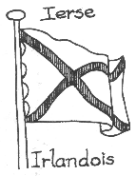
In addition, a book published in the Netherlands in 1693, Neptune Francois, illustrated the flags of the nations of Europe. It describes the ‘Ierse Irlandois’ flag as a white flag bearing a red saltire. Another book, De Doorliughtige Weerld, published in 1700, describes the flag of Ireland as a ‘white flag with a red St Andrew’s Cross’. A contemporary picture map of the siege of Duncannon Fort, Co Wexford, in 1645 described by Hayes-McCoy shows forces of the Catholic Confederation marching behind a Red and White Saltire. These forces had no Fitzgerald connections.
Given this evidence, it is not possible to dismiss the authenticity of the Cross of St Patrick. It has gained widespread acceptance since the formation of the Order of St Patrick in 1783. Defaced versions of the Cross of St Patrick have been used by the Catholic Boy Scouts of Ireland, Irish Freemasons, the former Irish state-owned shipping line, Irish Shipping Ltd, General O’Duffy’s Blueshirts and the Irish Guards regiment of the British army. Today, it appears in the arms of Queens University, Belfast and it has been adopted as the ‘neutral’ centrepiece of the badge of the new Police Service of Northern Ireland. It is carried every year as a non-partisan symbol in the St Patrick’s Day celebrations in Saul, Co Down – the reputed site of the saint’s grave.
Certainly, the St Patrick’s Cross has its detractors. Catriona Ruane, the former organiser of the West Belfast Community Festival, rejected the Saltire out of hand when she was behind the Belfast St Patrick’s Day festivities. She didn’t want any flag linked ‘with a regiment of the British army and the fascist Blueshirts’. She was happy to damn the Cross of St Patrick by association, but she seemed to have no problem with a flag associated with IRA death squads. This flag - the Tricolour - has no historical connection whatsoever with Patrick and no history in Ireland before March 7th 1848, when it was first publicly unveiled in Waterford by Thomas Francis Meagher, a leader of the Young Ireland movement. In the early part of the Twentieth Century it was known as the 'Sinn Féin flag' as in the republican song Johnston's Motor Car.
Despite this, the Cross of St Patrick flag has begun to gain a greater recognition and acceptance. In May 1999, the General Synod of the Church of Ireland passed the following resolution: The General Synod of the Church of Ireland recognises that from time to time confusion and controversy have attended the flying of flags on church buildings or within the grounds of church buildings. This Synod therefore resolves that the only flags specifically authorised to be flown on church buildings or within the church grounds of the Church of Ireland are the cross of St Patrick or, alternatively, the flag of the Anglican Communion bearing the emblem of the Compassrose. Such flags are authorised to be flown only on Holy Days and during the Octaves of Christmas, Easter, the Ascension of Our Lord and Pentecost, and on any other such day as may be recognised locally as the Dedication Day of the particular church building. Any other flag flown at any other time is not specifically authorised by this Church."
This resolution was passed to take an official stand against the practice of flying the Union Flag from local church buildings during the month of July each year. The General Synod regards this practice as involving the Church in party politics. Like the organisers of the St Patrick’s celebrations in Saul, the General Synod regards the Cross of St Patrick as a non-partisan symbol.
The Ulster National Flag overlays the red Cross of St Patrick on the blue background of the Cross of St Andrew. This emphasises the coming together of people from Scotland and Ireland to form the Ulster nation. Similar designs can be seen today on the flags of Jamaica, the Confederate naval jack and battle flag, and the state flags of Alabama and Florida.
David Kerr
The Union of Crowns of Scotland and England brought into existence the first Union Flag (Centre). The addition of the Cross of St Patrick after the Act of Union in 1801 brought about the current Union Flag (Right).
Reference:
History of Irish Flags. G A Hayes-McCoy
Academy Press, Dublin 1979, pp 32 – 41.
Traditional Roots. Earl Storey.
Columba Press, Dublin 2002, pp 116-119 & 133.

